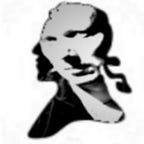To summarize the role of one, we find we may use the words of mathematician Leopold Kronecker to embody the idea, here only slightly rephrased for clarity, not really changing the original meaning however. The Kroneckerian dictum, which should be accepted as dogma, states:
One made natural numbers; all else is the work of man.
If this is so, we arrive at funny but inescapable conclusions. We must now make a tangential excursion in our search for recursion, to see what the above incurs.
5
If, say, five is also its reciprocal, five equals 0.2. If five equals 0.2, the mean positive value of five — ’generic five’ at near-optimum — equals 5.1.
Parenthetically: Note that this holds also for the reciprocal 0.2! The generic five range not only considering optimum, thus covers the entire stretch from -5 — +5.2. Note that as we consider positive values more real than negative ones, the center of the stretch is not on zero but on the reciprocal. For the center to be on zero we would have needed to consider -0.2 to be a reciprocal of five, but that would have required it both to be reciprocal and to be negative, meaning two operations would have needed to be carried out.
In other words, five is indeterminate. Or, if you will, it is not only a point, it has extension too. We may consider it a numerical atom of indeterminate size, the point associated with a particular numerical ’domain’.
Let us look at another example.
10
If ten equals 0.1 reciprocally, the already looked at mean positive value of five qua deviation from five proper equals ten. As ten is also two times five, mean positive value equals double. Nota bene, this is true for five, and for five only. What is strictly unfive is also undoublable. Mean positive and double converge at 5.
Having touched doubling, let us now look at…
2
The reciprocal of two is 0.5. Its mean deviation is thus 0.25. The positive mean corresponds with 4, which is 2 to the power of two; ’two-squared’. The mean positive value of two is thus 2^2 or, alternatively, two plus two. It seems doubling was not undoable if unfive after all.
Oh, wait, as we started with noting how two and five and ten were interrelated and concerned with the idea of doubling, we are really only extending outward from the basic five/two/ten-relationship. We need to consider four, too, to be not unfive.
4
What do we get for four? Four has the mean deviation of 0.125, corresponding to 8. The mean deviation of a square is thus a cube. Four also being a self-dual addition, we know that self-dual additions — another way of saying ’doublings’ — have a mean deviation that equals the cube.
As certainly as 2 brought us to four, 8 will move on to 16, and we know that story will give 32, 64 and the entire family tree of 2, 4 and 8 if repeating the same self-dual additions. The idea of mean deviation being ’half’ it is a given that all numbers that are multiples of two will show this relationship in some form.
Let us continue with eight.
8
Eight being the sum — or product — of two self-dual squares and itself a self-dual cube it is not the sum of a self-similar cube. In self-similar terms it is both sum and product, but its continuously self-similar dimension is cubic, not square. Continuously self-similar here means that only one integer and only one kind of operation is needed for its production. That the operation needs to be repeated is tautological, as self-similar indicates this.
Let me now introduce the idea that we may consider four to be a Tetrahedral Number, as it is indeed such a number. If so, we need to talk about four again.
Tetrahedron
If four is tetrahedral, it means it is both a representative of the idea of twodimensionality via the square and of threedimensionality via the tetrahedron. If told there is a geometry that is self-similar and made up from four different points, we would not know whether a square or a tetrahedron was implied. From this we must the number four as being in some way in itself indeterminate when it takes expression in the geometrical realm.
Let us look at something different.
8^x
If we think of eight in geometrical terms we may think of it as a collection of eight units in internal geometrical relationship. Naturally, numerically the number of possible combinations is infinite, so we shall restrict ourselves to geometries that are ordered according to principle, and to the most basic form if there are several variations.
Eight points referencing a common center equally spaced along a circumference would be an octagon, but the center is really a potential centerpoint, so we shall disregard that option for now.
The numerismatic series continues here.
